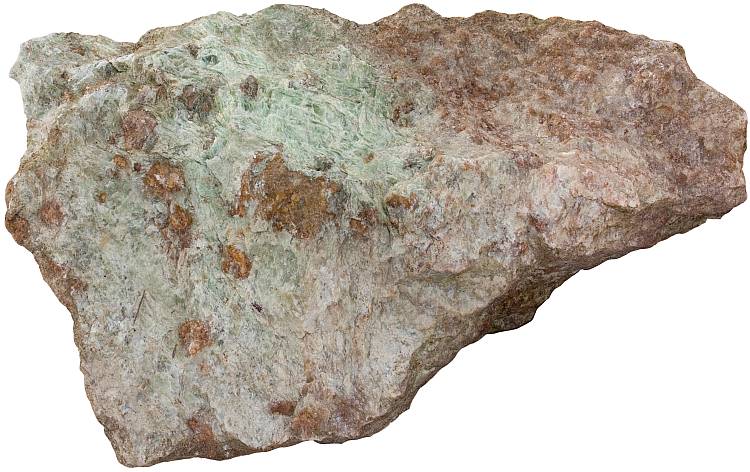Andalusite is an aluminum-rich silicate mineral. Andalusite is a common mineral in aluminum-bearing metamorphic rocks. It forms at low to medium temperatures and pressures. It is trimorphous with sillimanite and kyanite. It means that these three minerals have the same chemical composition, but they have different crystalline structure and therefore quite different appearance. The chemical composition of these three minerals are often expressed the following way: Al2SiO5 but not always. Sometimes it is written as AlAlOSiO4 or Al2OSiO4 to show that they are orthosilicates.
http://picasaweb.google.com/107509377372007544953/Rocks#5802927328818088386
Andalusite crystals are often large enough to be seen with the naked eye and have a characteristic square-shaped cross-section. Mn-rich variety from The Vosges Mountains, France. The width of the cross-section of the largest crystal is 16 mm.
Orthosilicates are silicate minerals which possess isolated silica tetrahedra (SiO4) in their crystal structure. These tetrahedra are like three-dimensional islands surrounded by other elements. Other well-known orthosilicates are zircon, olivine, garnet, topaz, titanite, etc. These are the least siliceous minerals among the silicate minerals and their chemical formula is usually written in the way which clearly shows isolated silica tetrahedra as an important structural unit. If we write the chemical formula as Al2SiO5, then we set these three silicates artificially apart from their relatives.
Andalusite, kyanite, and sillimanite have quite distinctive appearance from each other. Andal. crystals (they are commonly large enough to be seen) are elongated and have almost square cross-section. Kyanite is also elongated, but it is bladed and often has a distinctive bright blue color. Sillimanite is usually fine-grained, crystals are elongated as well, sometimes fibrous (variety known as fibrolite).

Andalusite (brown) in andalusite-sericite schist. Kapteeninautio, Finland. Width of sample 12 cm.
Andalusite is usually pink but white, gray, yellow, green (greenish gray), and violet varieties also occur frequently. Variation of color is mostly due to chromophore elements. Iron gives pink coloration, manganese is responsible for greenish hue1. Andalusite is usually relatively pure, but it may contain manganese and iron (both are chromophores) that replace aluminum in the lattice. Andalusite variety chiastolite contains dark carbonaceous inclusions that form a cross along the diagonals of the prism. Andalusite may easily alter to sericite (fine-grained muscovite) or to other sheet silicates. Variety chiastolite is especially prone to such alteration which starts from the contact surface between andalusite and carbonaceous inclusions1. Other inclusions like quartz, opaque minerals, and other minerals are also common in the crystals but they are small, visible with a microscope only. Andalusite is physically hard mineral (7.5 on Mohs scale), but it may be less on the surface because of alteration4.
http://picasaweb.google.com/107509377372007544953/Rocks#5802927328912521090
Porphyroblasts of andal. variety chiastolite (note diagonal dark zones) in a metamorphosed claystone from Germany. Chiastolitic cruciform pattern (visible when crystals are cut at right angles to the longest axis of the prism) forms because growing andalusite crystal pushes impurities aside as it grows. Initially in was unable to free itself from all types of inclusions, but as the crystals grow bigger they become more and more clear1. Width of sample 11 cm.
Andalusite occurs chiefly in metamorphic rocks. These metamorphic rocks are rich in aluminum. The protoliths are sedimentary rocks that consequently also have to contain lots of aluminum. These are sedimentary rocks that are rich in clay (shale, argillite, mudstone, etc.). All clay minerals contain lots of aluminum. It is the least dense of the three polymorphs (andalusite, kyanite, sillimanite) and is therefore stable at lower pressure. If pressure rises, andalusite transforms to kyanite. If temperature rises much faster than pressure, then sillimanite is the most stable of the three. All of them occur in metamorphic rocks which makes them very good indicators of the metamorphic conditions during their formation. Andalusite is no longer stable if the temperature rises approximately above 600 °C and the pressure over 4 kbar (diagram below) which equals about 12…14 km depth in the crust.
Andalusite is a common mineral in hornfels. Hornfels is a fine-grained metamorphic rock formed by contact metamorphism – baked sedimentary rock next to hot magma intrusion. It is also common in regionally metamorphosed (related to mountain-building events) rocks like slate and mica schist and may occasionally occur in granitic igneous rocks. Andalusite is not particularly stable in the weathering environment, but it may be found in sand and sandstone if low to medium grade metamorphic rocks are not too far away. Andalusite and kyanite are used as a refractory source material. They are heated to produce mullite (andal. needs to be heated to 1450…1500 °C) which is used to make bricks resistant to high temperature and other fire-resistant materials (in spark plugs3, for example). Sillimanite is rarely used for that purpose because it tends to be too fine-grained which makes it difficult to extract sillimanite from rocks and it requires higher temperature to mullitize. Largest commercial deposits are in South Africa. Transparent crystals may serve as gemstones. Andalusite was first described in Andalusia (Spain), and was named after this region4.
http://picasaweb.google.com/107509377372007544953/Rocks#5803213760299186690
Stability fields of aluminum silicates2. Andalusite is stable at low pressure and temperature. 1 kbar equals roughly 3.5 km depth in the continental crust.
References
1. Deer, W. A., Howie, R. A. & Zussman, J. (1996). An Introduction to the Rock-Forming Minerals, 2nd Edition. Prentice Hall.
2. Nesse, William D. (2011). Introduction to Mineralogy, 2nd Edition. Oxford University Press.
3. Klein, C., Hurlbut, C. S. (1993). Manual of Mineralogy, 21st Edition. John Wiley & Sons.
4. Hurlbut, C. S. (2007). Andalusite. In: McGraw Hill Encyclopedia of Science & Technology, 10th Edition. McGraw-Hill. Volume 1. 652-653.
Leave a Reply